Created cell programming language using DNA molecules

Engineers from the University of Washington have developed a structured set of instructions for programming chemical reactions in a laboratory environment or living cell using DNA molecules. The presence of such a language should help in the design of complex molecular structures with the desired properties.
DNA is a molecule consisting of four nitrogenous bases (A, G, T, C), which allows encoding information for protein synthesis through transcription into RNA on its matrix in the quadruple number system. It is DNA molecules that, by executing their code in a certain sequence, despite their simplicity and small size, allow cells to construct an organism of almost any complexity, even a human. At the same time, the DNA molecule provides an amazing data recording density, high reliability and a multi-level system for protecting information from damage. For chemists and computer scientists, this is an ideal container for recording information; they recently achieved a recording density of 2.2 petabytes per gram of molecules .
Specialists from the University of Washington went even further. “We start with an abstract, mathematical description of a chemical system, and then we use DNA to construct molecules that implement the required dynamics,” explains Georg Seelig, assistant professor of electrical engineering and computer science, one of the authors of the new programming language. “As a result, the thought comes to life, so you can use this technology to create general-purpose tools.”
')
Such synthetic DNA acts as a controller with molecular control chains, but based on which you can perform calculations and necessary chemical actions at the cellular level, as shown in the diagram.

Ideally, a universal framework will appear in the arsenal of scientists, suitable for programming cells or, in this sense, chemical computers. They will be able to follow instructions given not by nature, but by man. Although this is not a reverse engineering of the language of nature, but a similar framework that emulates its functions at the most basic level. For example, we can make living cells respond to specified chemicals - and work as biosensors. Such small “computers” can even be introduced into a person to perform a certain primitive task, for example, drug delivery. Moreover, they can be programmed to execute different programs, depending on the need.
The results of the work of scientists published on September 29 in the journal Nature Nanotechnology.
Source: https://habr.com/ru/post/196048/
All Articles